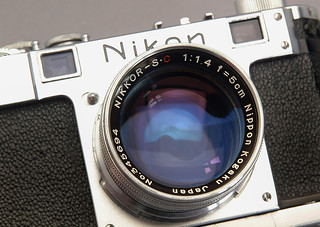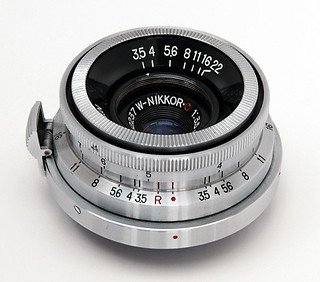Difference between revisions of "Nikon rangefinder lenses"
Hanskerensky (talk | contribs) m (→Links: Removed commented out Link URL, page still not present) |
(Added a reference from zeisscamera.com about the difference between inner mounted lenses in Nikon vs Contax) |
||
| Line 4: | Line 4: | ||
Whether related to patents, differing initial engineering decisions, or by mistake, the rangefinder coupling of its lens mount was slightly different than that of the Contax. The result is that the wide angle lenses, because of their wider depth of field, can interchange between the two types of bodies, but the standard and tele lenses cannot. There are Nikon versions and Contax versions of all focal lengths above normal. This proves that there was, indeed, an acknowledged difference in coupling. Nikon apparently made an engineering decision that the disparity was not significant at wider focal lengths. However, there is some discussion as to whether the problem is also apparent for normal lenses at close distances, as discussed by Dr. Bruce E. Sirovich in a Nikon Historical Society Article. | Whether related to patents, differing initial engineering decisions, or by mistake, the rangefinder coupling of its lens mount was slightly different than that of the Contax. The result is that the wide angle lenses, because of their wider depth of field, can interchange between the two types of bodies, but the standard and tele lenses cannot. There are Nikon versions and Contax versions of all focal lengths above normal. This proves that there was, indeed, an acknowledged difference in coupling. Nikon apparently made an engineering decision that the disparity was not significant at wider focal lengths. However, there is some discussion as to whether the problem is also apparent for normal lenses at close distances, as discussed by Dr. Bruce E. Sirovich in a Nikon Historical Society Article. | ||
| + | The main difference seems to arise from a 0.31mm difference in the thickness of the cameras, having a difference in inner mounted lenses such that the film to lens distance at infinity is 26.51 mm for Nikon and 26.82 for Contax. <ref>[http://www.zeisscamera.com/articles_cnrfdr.shtml Zeisscamera article about Nikon to Contax differences] by Henry Scherer </ref> | ||
Nikon used that same mount on all its rangefinder bodies until and including the [[Nikon rangefinder|Nikon SP]], and on the recent revivals [[Nikon rangefinder|Nikon S3 2000]] and [[Nikon rangefinder|Nikon SP 2005]]. | Nikon used that same mount on all its rangefinder bodies until and including the [[Nikon rangefinder|Nikon SP]], and on the recent revivals [[Nikon rangefinder|Nikon S3 2000]] and [[Nikon rangefinder|Nikon SP 2005]]. | ||
Revision as of 16:05, 10 December 2021
Nikon began the production of cameras with a line of Nikon rangefinder models. The first one was the Nikon I launched just after World War II. On this camera, Nikon copied the Contax rangefinder mount designed before the war by Zeiss Ikon and introduced with the Contax I.
Whether related to patents, differing initial engineering decisions, or by mistake, the rangefinder coupling of its lens mount was slightly different than that of the Contax. The result is that the wide angle lenses, because of their wider depth of field, can interchange between the two types of bodies, but the standard and tele lenses cannot. There are Nikon versions and Contax versions of all focal lengths above normal. This proves that there was, indeed, an acknowledged difference in coupling. Nikon apparently made an engineering decision that the disparity was not significant at wider focal lengths. However, there is some discussion as to whether the problem is also apparent for normal lenses at close distances, as discussed by Dr. Bruce E. Sirovich in a Nikon Historical Society Article.
The main difference seems to arise from a 0.31mm difference in the thickness of the cameras, having a difference in inner mounted lenses such that the film to lens distance at infinity is 26.51 mm for Nikon and 26.82 for Contax. [1]
Nikon used that same mount on all its rangefinder bodies until and including the Nikon SP, and on the recent revivals Nikon S3 2000 and Nikon SP 2005.
Surprisingly, the new Voigtländer marque, owned by Cosina, also launched a new rangefinder body in 2002 using the Nikon RF mount, called the Bessa R2S.

|
| Nikkor-S 5cm f/1.4 lens image by Geoff Harrisson (Image rights) |

|
| W-Nikkor-C 3.5cm f/3.5 lens image by Geoff Harrisson (Image rights) |

|
| Nikkor-Q 13.5cm f/3.5 lens & finder on a Nikon S image by Geoff Harrisson (Image rights) |
Contents
Nikon
The original lenses for the Nikon rangefinder models.
Nikon also made some these lenses for the original Contax mount. They are marked with a C on the barrel, unrelated to the red C on the front ring of the coated lenses.
Other lenses
Fuji
- Fujinon 5cm f/1.2
Link:
Komura
Made by Sankyo Koki.
- 35/2.8 W-Komura, black with wide chrome stripes, N on lens barrel
- 80/1.8 Komura, black with wide chrome stripes, finder, N on lens barrel
- 135/3.5 Komura, black, chrome nose and mount
Soligor
- 135/3.5, black and chrome
Tanaka
See the main article on Tanar lenses.
- W Tanar 35mm f/2.8, black and chrome, external finder
- Tele-Tanar 13.5cm f/3.5, black and chrome, external finder (also made in Contax mount; the Nikon edition has a small N at the rear end)
Taylor & Hobson
A Taylor, Taylor & Hobson Cooke Amotal Anastigmat 2in f/2 was sold mounted on a Nikon S body at Christies 8/6/1995, it is unknown if it was original.
Voigtländer
The range of lenses launched together with the Voigtländer Bessa R2S.
Zunow
Teikoku Kogaku, better known as Zunow, made some lenses in Nikon RF mount. Some had spectacular characteristics, and all are very rare.
- 50/1.1, all chrome
Reflex housings
Nippon Kōgaku made its own reflex housing for the rangefinder cameras, in two main versions.
The reflex housings made in Contax mount should be compatible with the Nikon rangefinder bodies, notably all the Zeiss Ikon models, and the Mirax-B by Orion Seiki and later Miranda Camera.
Links
In English: